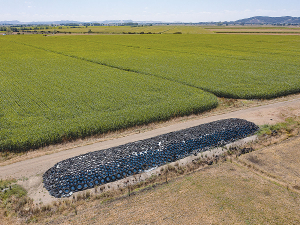Hitting heifer liveweight targets
Early December marks a key transition for many dairy farmers, as weaned replacement heifers head off-farm to grazing.
 Maize is a deep rooting, C4 plant, that has greater drought tolerance and better water use efficiency than pasture and many other crops.
Maize is a deep rooting, C4 plant, that has greater drought tolerance and better water use efficiency than pasture and many other crops.
My wife and I recently travelled to England to attend a family wedding in rural Kent.
It was impossible not to notice the major impact the weather was having on pastures and crops.
We travelled by train through France and Germany to visit friends in Switzerland where, kilometre after kilometre, we saw brown fields and crops that were struggling under extreme moisture stress.
This morning I read an article quoting Tristan Meyers, a meteorologist from NIWA. It stated that one of the biggest marine heatwaves ever is on its way. The article predicted this could result in other long, hot summer, similar to the one New Zealand experienced last summer and a replica of what my wife and I saw in Europe. While this may be hard to believe given just how wet the soil is currently, it would make sense to prepare for a hot, dry summer just in case. Steps that can be taken now are as follows:
Aim to produce as much milk as possible before the end of December
I started my career as a consultant in Northland where the climate was extremely variable. The higher producing farmers I worked with aimed to have 70% of their budgeted milk in the vat by the end of December. Maintaining pasture quality and keeping cows well fed over the next few months will be vital to maximising production prior to the end of the year. If you can make pasture silage, do so. Harvest it prior to 10% seed head and use a high quality inoculant to keep the quality up. Consider cropping an extra paddock which will help keep the pressure on the remaining grazing area maintaining feed quality.
Identify paddocks that need renewal because of pugging
As I move around the country, I note that the wet winter/early spring has resulted in a lot of pugging. Depending on soil type, that damage can have a major impact on subsequent pasture production. Many pugged paddocks are unlikely to recover by summer, identify these now and work out a summer cropping program. To maximise yield plant your crop as soon as the soil conditions allow.
Grow maize for silage
Of course, I am going to say this! However, the data is clear. Maize is a deep rooting, C4 plant, that has greater drought tolerance and better water use efficiency than pasture and many other crops. The wide range of maturities available allow farmers to plant maize from mid-September right through to late November or early December in many areas. Local merchant representatives work alongside Pioneer® brand maize area managers to help farmers select the right hybrids for their farms. They also provide great advice to ensure the crop grows well.
Order your bought in maize now
With the cost of imported feed significantly higher than it was 12 months ago, there is a increased demand for cost-effective locallygrown supplements. Making sure you have enough feed to cover the coming summer requires good planning. As you read this article, maize silage contract growers are planting their crops. To order maize silage or increase your order volume, contact your supplier as soon as possible.
While the milk price is high, the combination of high supplement prices and the threat of a hot, dry summer could challenge production and profitability. Maximise spring and early summer milk production and do some planning now to avoid an expensive, last minute scramble for feed.
Ian Williams is a Pioneer forage specialist. Contact him at This email address is being protected from spambots. You need JavaScript enabled to view it.
When American retail giant Cosco came to audit Open Country Dairy’s new butter plant at the Waharoa site and give the green light to supply their American stores, they allowed themselves a week for the exercise.
Fonterra chair Peter McBride says the divestment of Mainland Group is their last significant asset sale and signals the end of structural changes.
Thirty years ago, as a young sharemilker, former Waikato farmer Snow Chubb realised he was bucking a trend when he started planting trees to provide shade for his cows, but he knew the animals would appreciate what he was doing.
Virtual fencing and herding systems supplier, Halter is welcoming a decision by the Victorian Government to allow farmers in the state to use the technology.
DairyNZ’s latest Econ Tracker update shows most farms will still finish the season in a positive position, although the gap has narrowed compared with early season expectations.
New Zealand’s national lamb crop for the 2025–26 season is estimated at 19.66 million head, a lift of one percent (or 188,000 more lambs) on last season, according to Beef + Lamb New Zealand’s (B+LNZ) latest Lamb Crop report.
President Donald Trump’s decision to impose tariffs on imports into the US is doing good things for global trade, according…
Seen a giant cheese roll rolling along Southland’s roads?